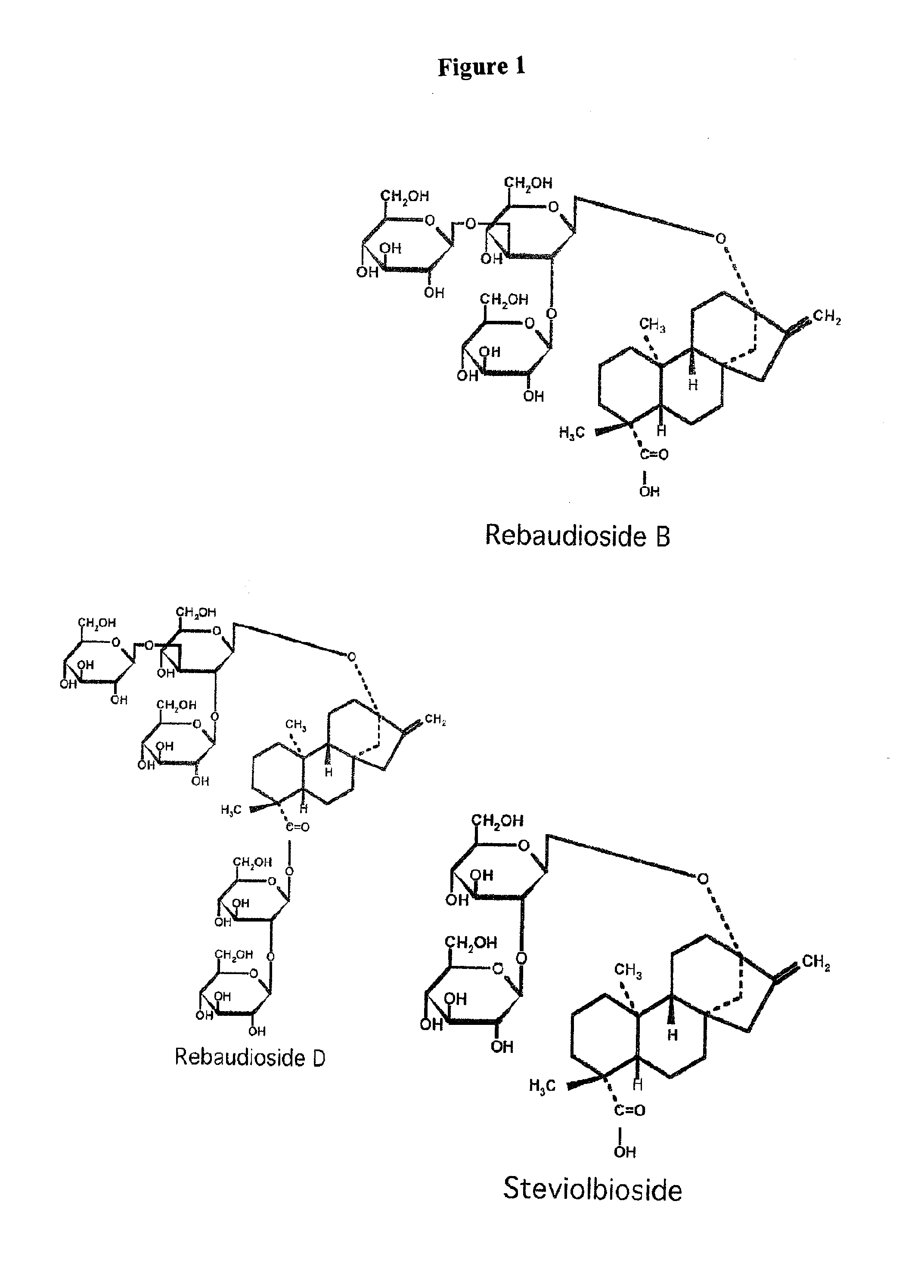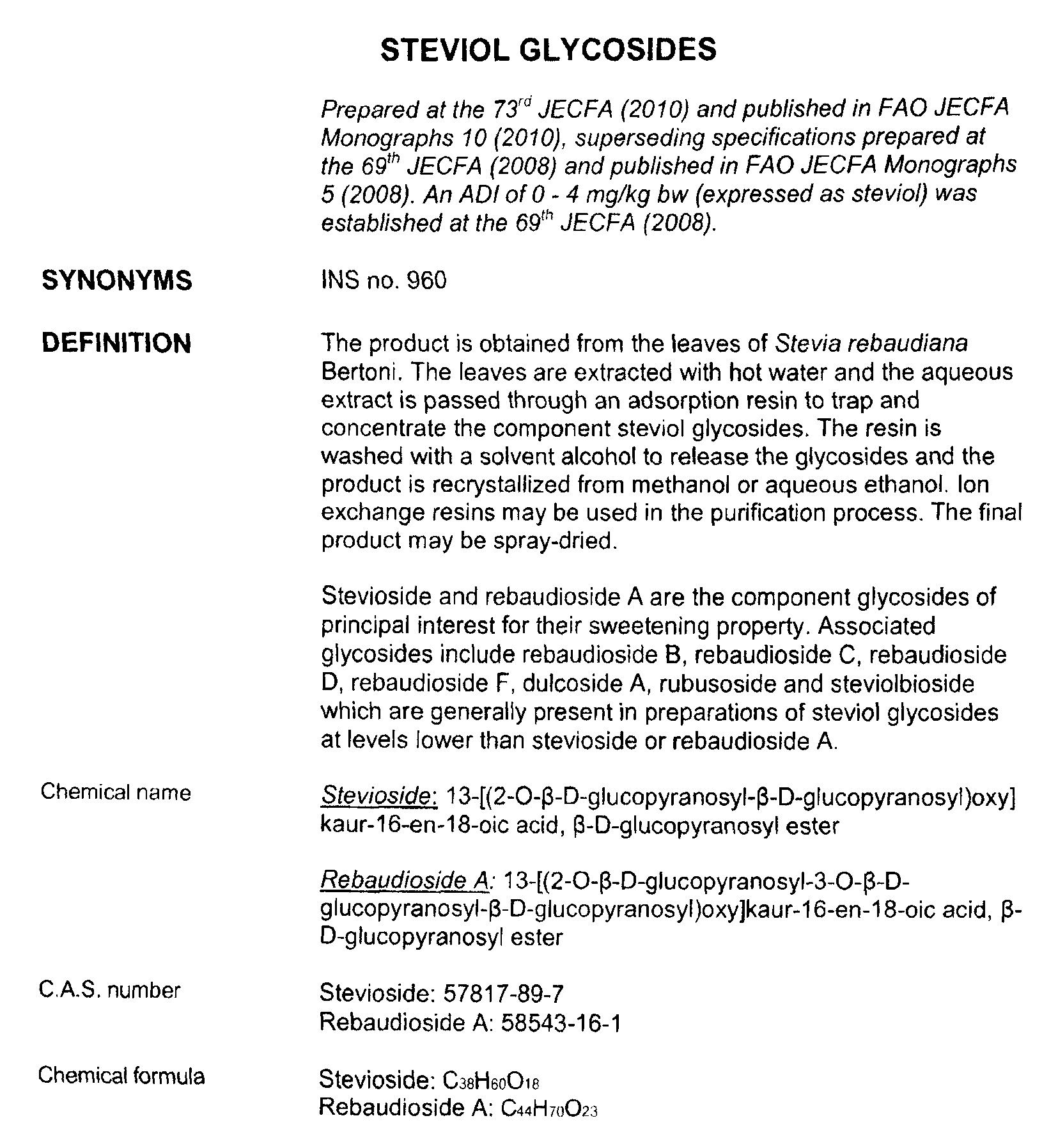Processes of Purifying Steviol Glycosides
a technology of steviol glycoside and purification method, which is applied in the field of natural sweetener compositions, can solve the problems of no good purification method for selective extraction, no good purification method, and high cost of natural sweeteners, and achieve the effect of reducing the adsorption capacity of the macroporous adsorption resin column and reducing the adsorption capacity
- Summary
- Abstract
- Description
- Claims
- Application Information
AI Technical Summary
Benefits of technology
Problems solved by technology
Method used
Image
Examples
example 1
Extraction of Steviol Glycosides from Stevia rebaudiana Leaves-Preparation of Mother Liquor
[0102]One kg of the stevia leaves known to have a high content of Rebaudioside A were steeped with 2 kg of room temperature water having a pH of 7.3 in an agitation centrifuge. The leaves were agitated for 0.5 hour. The sweet water was filtered, the filtrate collected and the process repeated for a total of 5 steep / separation cycles. The pH of the sweet water filtrate solution was adjusted to pH 8.0 with approximately 30 grams of calcium hydroxide. After a rest time of about 1 hour, 50 grams of FeCl3 was added to the sweet water filtrate solution to further adjust the pH to 7.0. The solution was filtered and the resulting filtrate had a transmittance of about 68±2% at 325 nm. The filtrate flows through the resin bed, and the glycosides was eluted from the resin bed by using 75% of ethanol. The eluate was concentrated to 45-50% of solid content, and then was vacuum dried. This dried eluate is c...
example 2
[0104]A mother liquor was taken, the RB content thereof was 27.12% as shown by the liquid phase chromatographic analysis, the mother liquor was prepared into a feed liquid with a concentration of 20 mg / ml, and the feed liquid was allowed to slowly flow through a 600 L DA-201-E resin column produced by Jiangsu Suqing Water Treatment Engineering Group at a flow rate of 2.0 L / min; the resin column selectively adsorbed the feed liquid according to the polarity of the individual components of Stevia rebaudiana glycoside as the feed liquid flowed through the resin column, the pH of the adsorption environment was 5.0, the feed liquid adsorption was completed after 15 hours, and Stevia rebaudiana glycoside adsorbed on the resin was desorbed by using 1600 L of 75% ethanol. The eluates were taken fractionally with 100 L as a unit, the RB contents were detected using liquid phase chromatographic analysis, it was found that a large amount of rebaudioside B was eluted out when the collected elua...
example 3
[0110]10 kg of crude Stevia rebaudiana glycoside prepared in example 2 with an RB content of 50.16% was taken and mixed with 22 kg of a mixed solvent prepared by mixing ethanol with a concentration of 78% and methanol of 43% in a proportion of 3:1, the resulting mixture was allowed to dissolve completely at 55° C. and rapidly cooled down to normal temperature within 5 mins, the mixture was stirred for 3 mins every 4 hours, it was left standing for 48 hours, the mixture after dissolution was subjected to solid-liquid separation, non-saline water was added to the solid which was filtered out to adjust its concentration to 27%, followed by concentrating to 43% and drying the solution to give 4 kg of refined Stevia rebaudiana glycoside.
[0111]The rebaudioside B content in the refined Stevia rebaudiana glycoside was 95.63%; and ethanol and the superfluous water were evaporated off from the liquid obtained by the solid-liquid separation, the concentration of the aqueous Stevia rebaudiana g...
PUM
| Property | Measurement | Unit |
|---|---|---|
| Temperature | aaaaa | aaaaa |
| Temperature | aaaaa | aaaaa |
| Temperature | aaaaa | aaaaa |
Abstract
Description
Claims
Application Information
 Login to View More
Login to View More - R&D
- Intellectual Property
- Life Sciences
- Materials
- Tech Scout
- Unparalleled Data Quality
- Higher Quality Content
- 60% Fewer Hallucinations
Browse by: Latest US Patents, China's latest patents, Technical Efficacy Thesaurus, Application Domain, Technology Topic, Popular Technical Reports.
© 2025 PatSnap. All rights reserved.Legal|Privacy policy|Modern Slavery Act Transparency Statement|Sitemap|About US| Contact US: help@patsnap.com



